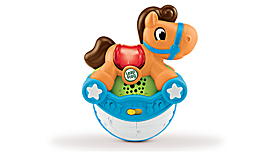Milestone moment: Roll over, Baby!

Rolling over typically occurs between 4-6 months. Try these tips and ideas to get baby rolling!
Surprise! It's the milestone that takes you by surprise: One day your baby stays put where you place him and then all of a sudden, off he goes, rolling around the room.
At this point, you begin to realize why they put straps on changing tables. Turn your back on your baby for thirty seconds to check your makeup or straighten your tie and you will find yourself diving to catch her.
Because you never know when your baby will suddenly decide to roll, you should always be careful to keep hands on your baby when she is on any elevated surface, like a bed, examining table, or changing table. My daughter was very impressed by her little trick and would purposely wait until my back was turned and then giggle as if to say, "Look at what I did!" My son, on the other hand, was a mobile roller...using rolling as an early means of locomotion throughout the house. Visitors had to be careful to watch their step.
When rolling happens
Rolling over typically starts at around 4-6 months; however, as with any milestone, there is a good bit of variation within the normal range.
Babies usually flip from front to back, first, so tummy time will encourage this movement. Because we put our babies "back to sleep" to reduce the risk of SIDS, babies are rolling later and later. This is not necessarily a bad thing—babies in traditional cultures are often carried all day in a sling until 6 months and they develop perfectly normally. Placing babies on their backs to sleep is very important—so make sure to limit the time spent flat on the back while your baby is awake. You can do this by wearing your baby and/or encouraging tummy time.
Encouraging rolling
There's no rush to roll but if you want to help your baby learn to roll, tummy time is key. My daughter loathed tummy time but as she became stronger and better able to lift up her head, she began to enjoy playing in this position.
- Get down with your baby: You are always the most interesting thing to your baby, so get down on your tummy with your baby and talk with her.
- Provide interesting toys: Musical toys, like the Learn & Groove Musical Table (with the legs removed) or the Learn & Groove Piano, placed on the floor may encourage your child to explore the world from this perspective.
- Dangle a lure: When your baby is on his tummy, lifting up his head, show him an interesting toy, possibly something with lights or a jingling noise. Slow lift the toy up and over your baby to his other side. If he follows the toy with his eyes, he may roll over to get a better view.
There's no need to rush this, or any other, milestone. If your baby is unable to lift her head or you sense something is "wrong," ask your pediatrician. Otherwise, just enjoy this special time with your little one because soon she will be rocking and rolling and moving and grooving all over the place!












